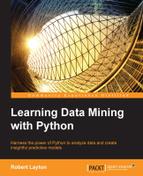In this chapter, we looked at using deep neural networks, specifically convolution networks, in order to perform computer vision. We did this through the Lasagne and nolearn packages, which work off Theano. The networks were relatively easy to build with nolearn's helper functions.
The convolution networks were designed for computer vision, so it shouldn't be a surprise that the result was quite accurate. The final result shows that computer vision is indeed an effective application using today's algorithms and computational power.
We also used a GPU-enabled virtual machine to drastically speed up the process, by a factor of almost 10 for my machine. If you need extra power to run some of these algorithms, virtual machines by cloud providers can be an effective way to do this (usually for less than a dollar per hour)—just remember to turn them off when you are done!
This chapter's focus was on a very complex algorithm. Convolution networks take a long time to train and have many parameters to train. Ultimately, the size of the data was small in comparison; although it was a large dataset, we can load it all in memory without even using sparse matrices. In the next chapter, we go for a much simpler algorithm, but a much, much larger dataset that can't fit in memory. This is the basis of Big Data and it underpins applications of data mining in many large industries such as mining and social networks.
